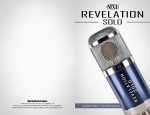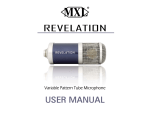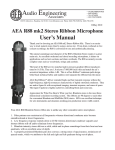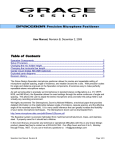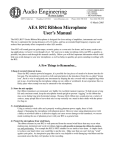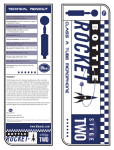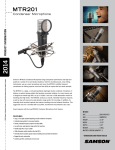Download - Soundpure.com
Transcript
C5 Small Diaphragm Cardioid Pencil Condenser Microphone Miktek, LLC 1200 Clinton Street, Suite 15 • Nashville, TN 37203 tel 615.250.2434 • fax 615.346.9298 ©2009 All Rights Reserved, Miktek. Printed April, 2010 v1.2 www. miktekaudio.com Table of Contents Introduction . . . . . . . . . . . . . . . . . . . . . . . . . . . . . . . . . . . . . . . . . . . . . . . . . . . . . . . . . 3 - 4 Features . . . . . . . . . . . . . . . . . . . . . . . . . . . . . . . . . . . . . . . . . . . . . . . . . . . . . . . . . . . . . . 5 Operating the C5 . . . . . . . . . . . . . . . . . . . . . . . . . . . . . . . . . . . . . . . . . . . . . . . . . . . . . 6 - 10 Understanding Polar Patterns . . . . . . . . . . . . . . . . . . . . . . . . . . . . . . . . . . . . . . . . . . . . . . . 6 Connecting your C5 . . . . . . . . . . . . . . . . . . . . . . . . . . . . . . . . . . . . . . . . . . . . . . . . . . . . . 7 Powering the C5 . . . . . . . . . . . . . . . . . . . . . . . . . . . . . . . . . . . . . . . . . . . . . . . . . . . . . . . 7 Setting Up the Signal Level . . . . . . . . . . . . . . . . . . . . . . . . . . . . . . . . . . . . . . . . . . . . . . . . . 8 Microphone Placement . . . . . . . . . . . . . . . . . . . . . . . . . . . . . . . . . . . . . . . . . . . . . . . . . . . 8 The Proximity Effect . . . . . . . . . . . . . . . . . . . . . . . . . . . . . . . . . . . . . . . . . . . . . . . . . . . . . 9 Stand Mounting the C5 . . . . . . . . . . . . . . . . . . . . . . . . . . . . . . . . . . . . . . . . . . . . . . . . . . . 9 Installing the SM5 Shockmount . . . . . . . . . . . . . . . . . . . . . . . . . . . . . . . . . . . . . . . . . . . . . 10 Applications Guide . . . . . . . . . . . . . . . . . . . . . . . . . . . . . . . . . . . . . . . . . . . . . . . . . . . 11 - 19 Acoustic Guitar . . . . . . . . . . . . . . . . . . . . . . . . . . . . . . . . . . . . . . . . . . . . . . . . . . . . . . . 11 Piano . . . . . . . . . . . . . . . . . . . . . . . . . . . . . . . . . . . . . . . . . . . . . . . . . . . . . . . . . . . . . 12 Overhead Drum Kit . . . . . . . . . . . . . . . . . . . . . . . . . . . . . . . . . . . . . . . . . . . . . . . . . . . . 13 Hi Hat . . . . . . . . . . . . . . . . . . . . . . . . . . . . . . . . . . . . . . . . . . . . . . . . . . . . . . . . . . . . 14 Stereo Miking Techniques . . . . . . . . . . . . . . . . . . . . . . . . . . . . . . . . . . . . . . . . . . . . . . . . . 15 Coincidental - XY or Crossed pairs . . . . . . . . . . . . . . . . . . . . . . . . . . . . . . . . . . . . . . . . . . . 16 Near Coincidental . . . . . . . . . . . . . . . . . . . . . . . . . . . . . . . . . . . . . . . . . . . . . . . . . . . . . 18 Spaced Pairs . . . . . . . . . . . . . . . . . . . . . . . . . . . . . . . . . . . . . . . . . . . . . . . . . . . . . . . . . 19 Baffled . . . . . . . . . . . . . . . . . . . . . . . . . . . . . . . . . . . . . . . . . . . . . . . . . . . . . . . . . . . . 19 Specifications . . . . . . . . . . . . . . . . . . . . . . . . . . . . . . . . . . . . . . . . . . . . . . . . . . . . . . 20 - 21 You’ve done, done it….. You’ve purchased a truly exceptional piece of audio gear! Congratulations and thank you for purchasing the C5 or C5MP Pencil Condensers from Miktek. We know there are a lot of pretty good low cost microphones available today, but you’re in an elite group of audio engineers where pretty good is just not good enough. Simply put, that’s why we make our products. In the following sections of this manual you will find a description of the C5’s features, step-by-step set-up and operating instructions along with detailed specifications. In addition, we’ve also included some basic miking techniques for typical recording and live sound applications. Most of us who’ve purchased the C5 are already experienced engineers, so these may seem quite basic. However at Miktek, we want to encourage young or new engineers to use our microphones, or at least to read our manuals and learn something about recording and live sound. We know you’re serous about your productions because you purchased such an outstanding audio instrument, and at Miktek, we’re serous about providing superior products and service to our customers. We appreciate your patronage and hope you enjoying using your microphones as much as we enjoy making them. Sincerely, Michael Ketchell - Managing Director 2 Introduction The Miktek C5 provides discerning engineers a valuable new tool for critical recording, especially of acoustic instruments. The C5 is fitted with our MK5a, 0.5-inch cardioid capsule, which produces a super-linear, full-bodied response. The capsule employs a 5-micron tensioned Mylar diaphragm, on which a 0.5-micron layer of evaporated gold is applied. Tight tolerances and special attention to precise machining of the backplate, and acoustical porting, produces an off-axis response that ensures the accuracy of the microphone. The C5’s electronic circuit design is unique and features the AMI T5 transformer together with the implementation of high quality, exotic components including hand-selected transistors. The result is a sweet response reminiscent of the iconic classic mics of the past. The Miktek C5 is perfect for recording acoustic instruments including violin, acoustic guitar, mandolin, dobro, brass, woodwinds, and piano. And as expected, the C5 produces excellent results on drums as overheads and on hi-hats too. The C5 body is constructed of solid brass, and the platinum finish and stunning appointments make the mic as good to look at, as it is to hear. In order to ensure the utmost quality, each microphone is carefully hand assembled and tested in our factory in Nashville, TN USA. The microphone is available as single unit; model C5, or in a matched pair set; model C5MP. The C5 is packed in a wooden presentation box along with its proprietary mic stand holder. The C5MP set features two C5’s with frequency responses matching within 1dB. Also included in the C5MP is a wooden presentation box to hold the microphones pair, along with two mic stand holders, plus two shockmounts, two windscreens and a stereo mounting bar, all set in a rugged aluminum road case. Ideal for both recording and live sound application, the C5 will impress the most discriminating engineers, producers and artists. 3 Introduction With proper care your C5 will operate trouble free for many years. We recommend you record your serial number in the space provided below for future reference. Serial number:_______________________________ Date of purchase:____________________________ Be sure to complete the included warranty registration card or visit mikekaudio.com to register on line. In the unlikely instance that your microphone would ever require service, please contact us at 615 250 2434 for a Return Authorization number. If you purchased the microphone outside of the US, please contact your local distributor for service. Please feel free to call us with any questions you may have about this or any other Miktek product. 4 Features 77 MK5a 0.5-inch Cardioid Capsule with 5-micron Mylar, Evaporated Gold Diaphragm 77 AMI T5 Transformer 77 Hand-selected Transistors 77 Individual serialized Frequency Response Graph 77 Available as a single mic in a wood Presentation Case with Mic Clip; or 77 Available as a stereo matched pair with wood Presentation Case with Mic Clips, Shock-mounts, Windscreens, Stereo Bar Set, in a rugged aluminum carrying case 5 Operating the C5 Understanding Polar Patterns Perhaps the most important aspect of using your C5, or any other microphone, is to understand its polar pick up pattern. Every microphone has a characteristic polar pattern that determines how well it accepts or rejects signal coming from various areas around the microphone capsule. There are many types and variations of polar patterns but the three most common are omniderctional, bi-directional or figure-eight and unidirectional or cardioid. Omnidirectional microphones produce a linear response regardless of where the sound source originates (in front of the mic, behind it, to the side, etc.). A bi-directional or figure-eight microphone picks up directly sound from the front and back while rejecting the sound at the sides. In contrast, cardioid mics are specifically designed to accept the sound coming from directly in front, and to reject sound coming from behind or from the sides. The C5’s standard MK5a capsule provides a cardioid polar response and for added flexibility it can be removed and changed with the optional MK5b omnidirectional capsule. While Omni and Bi-directional microphones are very useful for a variety of applications, the majority of miking situations in recording and live sound applications require uni-directional or cardioid microphones. The cardioid pick-up pattern allows for better separation of instruments in the studio and more control over feedback in live sound reinforcement. When positioned correctly, the cardioid pattern allows you to pick up more of the sound you want and less of the sound you don’t want. In live sound situations, the polar pattern also determines how prone a particular microphone is to inducing feedback. Feedback is that nasty howling sound that occurs when a mic is placed too close to a loudspeaker—the signal from the loudspeaker is fed into the mic, then into the loudspeaker, then into the mic, over and 6 Operating the C5 over again until an oscillating tone is generated. The cardioid pattern utilized by the C5 is so good at rejecting signal not coming from directly in front of the microphone, you’ll find that use of the C5 greatly minimizes feedback problems when used in loud sound applications. Connecting your C5 Connect the C5 to your mixer, mic pre or DAW using a standard XLR microphone cable. In order to ensure the proper phase response, please note the C5’s output connecter is wired as Pin 1 Ground, Pin 2 hot or positive, and Pin 3 cold or negative. Also, it always a good idea to turn down your mixers main output level control when plugging or unplugging microphones so you can avoid any unwanted loud pops that could cause damage to your speaker system. Powering the C5 Since the C5 is a condenser microphone it needs to be operated by connecting it to a 48 volt Phantom power source. Most quality mixers, outboard mic pres and DAW mic channels have Phantom power available as a standard feature. You can also use an external phantom supply, if necessary. Since most mixers and outboard mic pres have a dedicated switch to engage the phantom power, be sure to check that the Phantom power is on. Once the Phantom power source is turned on, the C5 receives the phantom power directly from a mic cable. 7 Operating the C5 Setting Up the Signal Level In order to get a good signal, first be sure that the C5 is connected to a mixer or recorder input that is microphone level. As explained in the previous section “Powering the C5”, be sure that the Phantom power is turned on. Most quality mixers, mic pre’s and DAW’s provide microphone inputs with a mic trim (“trim” is jargon. the control is usually called Mic Gain or Level) control. The purpose of the mic trim control is to set a good signal level and minimize any noise associated with the mic inputs electronics. A good mic pre will also have a Clip or Peak LED to show you when the input is at overload, the level which distortion begins to occur. To set a good clean level, set the C5 up in front of the desired sound source and slowly turn up the mic trim until you see the Clip LED light up. Then, turn the trim control down until the LED does not light any more. On most microphone inputs, the best setting is when the trim control is turned up as high as possible without lighting the PEAK LED. Microphone Placement To help maximize the quality of your recording, you must pay careful attention to the placement of your C5, and specifically, how it is positioned for the instrument or vocalist that you’re miking. As you become more experienced in miking techniques, you’ll quickly realize the microphone placement is critical to getting the sound you want. Or more information on typical miking, see the Application Notes section of this manual. But remember, these examples are at best an approximation of where you should place the microphone to get the best sound. While placing the mic around any instrument or sound source, monitor the signal through a set of good quality closed-back headphones and take notice to how just a slight adjustment can make a huge change in frequency response. As you’re changing the microphone’s position, be sure to check that the mic input is still set to a good level without clipping, as described in the previous section. 8 Operating the C5 The Proximity Effect All cardioid or uni-directional microphones exhibit a phenomenon known as “proximity effect”. The proximity effect is the increase in low frequency response a microphone exhibits as it is moved closer to the sound source. Vocalist tend to love this effect since when they get really close to the mic they get the “FM radio”, big bass sound. A good vocalist with good mic technique will use the proximity effect to adjust their tonal response in real time. The key to developing the best mic technique is experimentation, along with awareness of the general principle that, the closer your C5 is to a signal source, the greater the bass response. The proximity effect’s bass lift is caused by the amount of pressure present at the ports that are used to create the directional pattern. Since omnidirectional microphones do not have ports, they do not have proximity effect. Stand Mounting the C5 The C5 can be mounted to any standard microphone stand using the included mic stand holder or the SM5 shock-mount. If you are using a US standard 5/8-inch mic stand, remove the Euro adapter by unscrewing it from the mic holder. Slide the microphone into the holder from the front to the back. 9 Operating the C5 Installing the SM5 Shockmount The C5MP kit comes with two SM5 shockmounts, which you can use to greatly reduce any noise transmitted through the mic stand. The shockmounts are especial useful in reducing the problems caused by a boomy soundstage, for example when miking overhead cymbals, or even in the studio with talent that likes to move a lot on a floor that may not be a solid as it should be. • T o use the C5 with their included shockmounts, screw the shockmount on a standard mic stand. If you are using a US standard 5/8-inch mic stand, remove the Euro adapter by unscrewing it from the shockmount. • Once the shockmount is mounted to the stand, carefully slide the C5 through the elastic bands of the shockmount from the front of the microphone to the back. • Loosen the thumbscrew to set the microphone angle and then tighten once it’s in place. 10 Applications Guide The C5 is a great microphone choice for many instrument miking situations. Below is a brief guide on using the C5 in some typical applications. But as a general rule of thumb, before you use a typical placement, carefully listen to what you are miking by having the artist play a practice track. Take a walk around the artist as they are playing and listen to what the instrument sounds like from different positions. Move left and right. Listen over the artist’s shoulders. Place your head up high and close to the floor. Imagine your ears are the microphones. What do you hear that you like? Then, once you choose your spot, monitor the signal through a set of good quality closed-back headphones and take notice to how just a slight adjustment can make a huge change in frequency response. However, before you get into experimenting, the following basic examples are a good place to start. Acoustic Guitar There are a variety of ways that the C5 can be used to mic an acoustic guitar. The correct placement will depend on the type of instrument and what kind of sound you’re looking to capture, for example the tonal quality you want to focus on, and how much finger slide or pick noise you may or may not want. When miking a standard steel string acoustic, a good place to start is with the microphone positioned pointing towards the end of the fingerboard at a distance of about 6 inches to 2 feet away from the instrument. You can experiment by moving the microphone slightly in the direction of the sound hole, which will produce more low frequencies, or move it in the direction of the 12th fret to capture more high-end or to remove any unwanted boominess. 11 Applications Guide Acoustic Guitar - continued For nylon string acoustic, try positioning the microphone above the bridge to emphasize more of the attack from the sound of the finger picking, or for less, move the mic closer to the sound hole. If you have a pair of C5’s, try one positioned at the fingerboard and the second over the sound hole. Try positioning one mic in the front of the guitar pointed towards the fingerboard and another over the right shoulder (right handed player). Important Note: When using multiple microphones you need to be aware of their phase response. In general, all the microphones need to be facing in the same direction or you will experience comb filtering and/or phase cancelation. For instance, in the previous example set up it will be necessary to invert the phase on the over the shoulder microphone since it will be more than likely end up facing the opposite direction as the front microphone. Any good mic pre will have a Phase reversal switch so be sure to reverse the phase of any mics facing the opposite direction. Piano You can achieve outstanding results using the C5 on acoustic piano. Several placement approaches can be used depending on the size of the piano, and the type of sound you are looking to record. When miking a Grand Piano, (for an ambient sound like that used in a classical recital), a single C5 can be positioned directly in front of the instrument. Open the lid to the full position and place the microphone five to twelve feet in front of the instrument. For a more contemporary sound with better isolation, place two C5’s inside the piano positioning one over the low strings and the other of the high 12 Applications Guide strings. To achieve a more realistic sound, it’s a good idea to leave some space between the instrument and the microphone, especially if you are recording a solo instrument. Also, keep in mind how the track ultimately needs to fit into the mix. For example, if you are recording a solo performance of Chopin, you would likely want a very even response and you’d want to capture the left hand sustianato. However, if you are recording rock and roll or pop music, you may want the piano to sit within the track in a specific frequency range where less bass is desired. Nashville engineers, and other good ones from all over the planet, are famous for building the mix as they track, starting with the microphone placement. Overhead Drum Kit Because of it’s extended high frequency response and fast transient response, the C5 performs outstandingly when used as an overhead cymbal microphone. But, since the C5 also has a thick bottom end response it can sound a lot like microphones with larger capsules, which makes them awesome on overheads. You can position one C5 on a boom mic stand directly above the kit pointing from front to back. For stereo miking, use two C5’s placed over the drum set at a distance of two to three feet depending on the size of the kit. You can experiment with the exact placement depending on the size of the room and whether you’re looking for an ambient or close-miked sound. You can also try the XY or ORTF stereo mic set-ups described in the following section, “Stereo micing Techniques”. In general, when miking a drum kit, it’s a good idea to start with the overhead mics. Even though you use the overhead mics mostly for the cymbals, try to get the entire kit to sound great in the overheads. Then it will be easier to just bring up your individual mics for more attack and thickness in the overall sound. 13 Applications Guide Hi Hat The C5 is a perfect microphone for miking Hi Hats thanks to its smooth top end and the ability to capture fast attack transients. Try placing the microphone over the edge of the top cymbal. Experiment by moving the mic further over the cymbal to produce more of a stick sound, but keep in mind it may pick up more of the kit. Remember that the C5 has a cardioid frequency response, so position the microphone in the direction of the Hi hat, but for increased separation, be sure to point the mic away from other drums or cymbals whenever possible. 14 Stereo Miking Techniques Stereo Miking Techniques Recording instruments like acoustic guitar, piano and drums, or ensembles (especially in classical or jazz), in stereo will provide a much more realistic experience for the listener. You can create a stereo recording by simply using your mixer’s or DAW’s pan controls to place different instruments in between the left and right speakers. However, since the recorded tracks were likely created with close miking, the stereo mix is void of a lot of information that the listener would normally enjoy in a live performance. When you record live tracks in stereo, not only will you capture the left and right position, but you can capture the perspective of depth and distance of each instrument. You’ll also capture an image that translates the distance between the ensemble and the listener, and, you capture the sound of the acoustic space surrounding the instrument or ensemble. When recording ensembles in stereo you have better chance of faithfully reproducing the balance between the instruments that was originally intended by the composer. For most stereo miking applications, you need to have two microphones with closely matching frequency responses and polar patterns. Depending on which miking technique you use, the stereo image is created when the combination of microphones pickup differences in level, time and frequency response. There are several time-tested techniques for recording in stereo including coincidental or XY pairs, near coincidental or AB, spaced pairs, and baffled. Following is a brief explanation of these common types stereo miking set ups. 15 Applications Guide Coincidental - XY or Crossed pairs Coincidental microphone set ups are where the two microphones’ capsules are set close together on the same axis. The most common of these is XY or crossed pairs. In the XY set up, the two microphone capsules are positioned on the same axis, one directly above the other with the capsules positioned on an angle from 90 to 120 degrees. You can use the C5MP’s included stereo mounting bar to set the mics in this position. The wider the angle, the wider the stereo spread. Since the microphones are set on the same axis, the distance is constant and there’s little or no delay difference. Therefore, the stereo image is created by the level difference of the left and right microphones. Since there is no appreciable delay, there is less of a chance for phase cancelation and comb filtering so you can good results when the stereo signal is combined to a mono signal. 16 Applications Guide MS – Mid side The Mid side technique makes use of two microphones, with one figure-8 and a second mic either cardidod or omni , or two figure-8 pick patterns. The first microphone (the mid), either figure-8, omni or cardioid microphone, is positioned facing directly at the sound source. The second microphone (the side), with a figure-8 pattern, is positioned on the same axis directly above or below the first, but with the capsules positioned at a 90-degree angle from the front. The outputs of the two microphones are often connected to a special MS matrix mixer, which combines the mid signal with the signal of the side microphone, both in phase and out of phase. The matrix mixer’s ratio control now used to set the balance between the mid mic and the combined signal of the side mics to adjust the width of the stereo spread. You can also connect the two microphones outputs to two inputs of a stereo mixer, let’s say channel one and two. Next, split the side signal into a third channel set to reverse phase. Pan channels two and three hard left and hard right respectively. Channels two and three should be at equal level and always adjusted the same amount as if they were grouped together. Now use the balance between channel one and the grouped channels two and three to adjust the width stereo spread. If you want to create the Mid-side stereo effect after you’ve recorded into your DAW, record the mid mic on track one, and the side mic on track two. Then, copy track two to track three, be sure they are aligned perfectly and then reverse the phase on track three. Now group tracks two and three together so they move with one fader. Then pan channel two hard left and channel three hard right. At this point you can adjust the width of the stereo image by change the balance between track one and the group channels two and three. 17 Applications Guide Near Coincidental Near coincidental or AB mic set up used two matched microphones set relatively close together, facing in opposite directions. The spacing between the microphones creates a time delay adding to the stereo effect. The greater the angle the greater the stereo spread. Less of an angle yields a more narrow spread. There are a few standards that specify different angles and spacing, with the most popular being the ORTF (the acronym given to the French Broadcasting Organization which stands for Office de Radiodiffusion Television Française). The ORTF standard specifies the capsules to be spaced 17cm apart and set at a 110-degree opposing angle. You can use the C5MP’s included stereo mounting bar to set the mics in this position. In this setup the stereo image is created by the differences between level and time. The stereo image is sharp however it tends not to be mono compatible. Spaced Pairs The spaced pair approach uses two identical microphones set rather far apart, for example 2 to 20 feet, or more apart, both facing directly at the sound source. The further apart that the micro phones are placed, the wider the stereo spread. 18 Applications Guide The instruments in the center of the two microphones will be heard midway between the left and right speaker. With greater distance, the off center images are less focused or more diffused. This set-up tends to capture more ambience from the acoustical space, which can be very pleasant to the listener, however the signal tends not to be mono compatible. In some instances were the microphones are very far apart, a third microphone can be used in the center to reinforce the clarity of the center image. Baffled In a baffled stereo set up, two omni directional microphones are placed roughly the distance between your left and right ears with a physical hard or foam baffle placed in-between the two mics. It uses time differences at low frequencies and level differences at high frequencies to create the stereo image. The baffle creates a difference in frequency response between the two microphones, with less high frequency content heard from the further microphone. Therefore with the baffled set-up, the stereo signal is achieved by the combination of the differences in level, time and frequency. With the baffled set-up the stereo image has a tendency to be exaggerated and not mono compatible. 19 Specifications 77 C5 Typical Frequency Response 77 C5 Polar Response 20 Specifications 77 Type . . . . . . . . . . . . . . . . . . . . . . . . . . . . . . . . . . . . . . . . . Small diaphram Condenser 77 Polar Pattern . . . . . . . . . . . . . . . . . . . . . . . . . . . . . . . . . . . . Cardioid 77 Frequency Response . . . . . . . . . . . . . . . . . . . . . . . . . . . . . . . . 20~20000Hz 77 Sensitivity . . . . . . . . . . . . . . . . . . . . . . . . . . . . . . . . . . . . . - 32.4 dBV/Pa 77 Equivalent Noise Level . . . . . . . . . . . . . . . . . . . . . . . . . . . . . . 17dB 77 Dynamic range . . . . . . . . . . . . . . . . . . . . . . . . . . . . . . . . . . . 109dB 77 S/N Ratio . . . . . . . . . . . . . . . . . . . . . . . . . . . . . . . . . . . . . . 77dB 77 Max. SPL . . . . . . . . . . . . . . . . . . . . . . . . . . . . . . . . . . . . . . 126dB 77 Power Supply . . . . . . . . . . . . . . . . . . . . . . . . . . . . . . . . . . . . 48V phantom 77 Power Consumption . . . . . . . . . . . . . . . . . . . . . . . . . . . . . . . . 0.5mA Specifications are subject to change without notice. 21 www. miktekaudio.com 1200 Clinton Street, Suite 15 • Nashville, TN 37203 tel 615.250.2434 • fax 615.346.9298 ©2009 All Rights Reserved, Miktek. Printed February, 2010 v1.1





























